Posted by: Northwest Eye in General on July 19, 2025
Overview
Pterygium surgery is primarily focused on removing abnormal tissue growth from the eye. We understand that this can be a concerning prospect for many patients. Techniques like conjunctival autografts are utilized to minimize recurrence and enhance recovery outcomes, providing reassurance during this process.
It’s important to understand the procedure, including recovery expectations and potential risks. This knowledge helps you make informed decisions about your care. We want you to feel prepared and supported throughout your surgical experience, knowing that you are not alone in this journey.
Introduction
Understanding the complexities of pterygium surgery is an important step for anyone facing this eye condition. We recognize that it can be daunting, especially given its potential impact on vision and overall eye health. Gaining insights into the surgical process, recovery expectations, and associated risks is essential for your peace of mind. This article explores seven crucial aspects of pterygium surgery, providing a comprehensive guide designed to empower you in making informed decisions.
What are the key factors that can influence the success of this procedure? How can you best prepare for your journey toward clearer vision? We are here to help you through this process, ensuring you feel supported every step of the way.
Northwest Eye: Expert Pterygium Surgery Services
At Northwest Eye, we understand that considering eye surgery can be a daunting experience. That’s why we are dedicated to providing expert services, utilizing and state-of-the-art technology. With over 50 years of experience in eye care, our focus extends to various eye conditions, including growths on the eye.
Our surgical team, led by compassionate and experienced ophthalmic surgeons, employs innovative methods such as in pterygium surgery. This technique has shown in various studies, which not only minimizes the likelihood of recurrence but also enhances overall patient outcomes.
Dr. Sharlene I. Noguera shares, ‘Pterygium surgery, specifically , has been our preferred surgical approach for over a decade, owing to its proven efficacy and favorable safety profile.’ We believe that personalized care is crucial, and we tailor our approach to meet your specific needs, ensuring a comfortable and effective surgical experience.
We also recognize that , including those highlighting the use of , continue to inform our best practices. This commitment ensures that Northwest Eye remains at the forefront of pterygium surgery management. Remember, we are here to help you through this process, providing the support you need every step of the way.
Understanding Pterygium: Causes and Symptoms
Pterygium, often referred to as ‘surfer’s eye,’ is a benign growth of tissue on the conjunctiva that can encroach upon the cornea. We understand that this condition can be concerning, especially since it is primarily triggered by , alongside environmental factors like dust and wind. Symptoms frequently manifest as:
- Redness
- Irritation
- A sensation of a foreign object in the eye
These symptoms can also suggest underlying issues such as , diabetic retinopathy, or dry conditions. Early recognition of these symptoms is crucial; can prevent serious health complications and improve outcomes.
Eye care specialists emphasize the importance of , particularly for those with outdoor occupations or individuals living in sunny climates. For instance, Jerome P. Fisher, MD, wisely remarked that “patients with the eye condition should limit exposure to ultraviolet light whenever feasible.” Treatment options may include lubricating eye drops and, if necessary, .
It’s common to feel overwhelmed when faced with these symptoms, but , such as blurred vision, can lead to more effective management and treatment choices. We are here to help you through this process, ensuring that you .
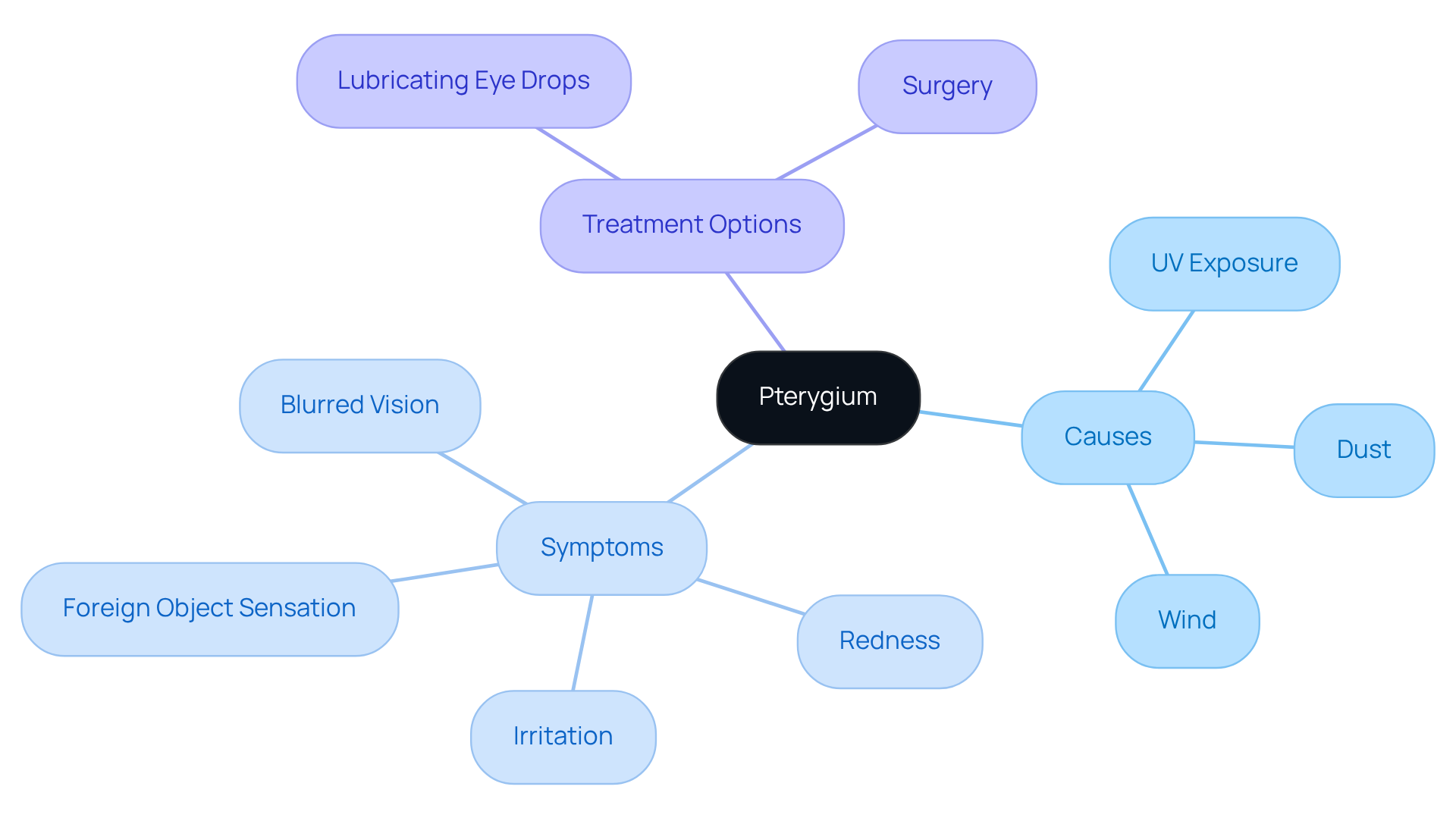
Pterygium Surgery: What to Expect During the Procedure
We understand that undergoing an can be a . During the procedure, the surgeon will carefully extract the . Typically, this process lasts about 30 to 45 minutes and is performed under local anesthesia. While some patients may experience mild discomfort, rest assured that is generally well-tolerated.
To enhance your recovery, the surgeon may use techniques such as to cover the area where the growth was removed. This method significantly reduces the , giving you .
We encourage you to you may have prior to the procedure. ensures a seamless experience, and we are here to help you through this process.
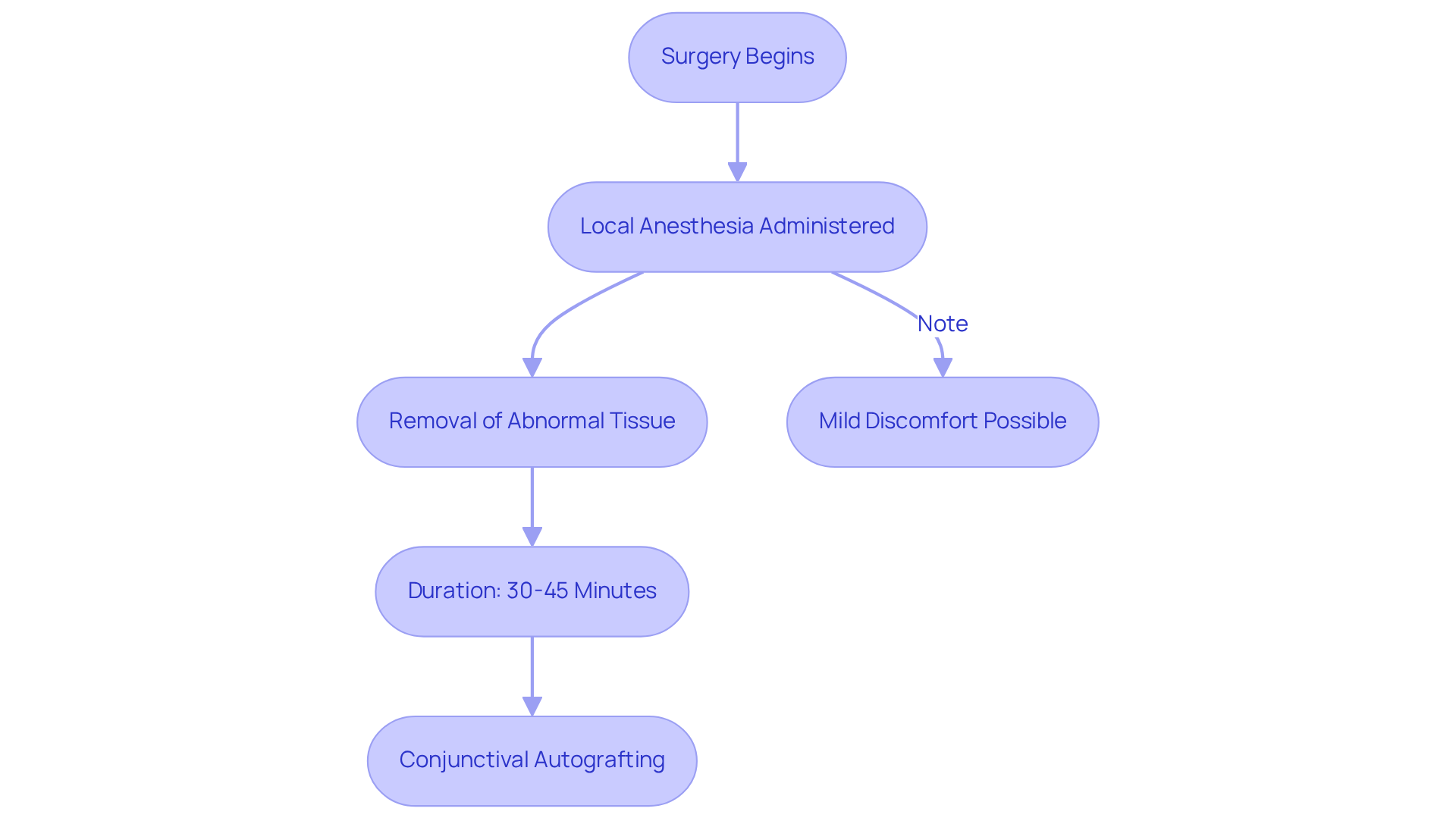
Recovery from Pterygium Surgery: Key Considerations
Recovery from typically spans several weeks and necessitates attentive care. We understand that in the initial days following surgery, you may observe . Adhering to post-operative instructions is crucial. This includes:
- Using prescribed antibiotic for the first week
- Following with for about six weeks to aid healing
- Avoiding strenuous activities
- Shielding your eyes from sunlight and irritants
are essential to monitor your recovery and address any concerns. Most individuals can , such as work and driving, within one to two weeks, although full recovery may require at least a month for your eye to appear normal and healthy again. It’s common to feel anxious about the healing process, but it’s important to recognize that while the pterygium surgery has a —usually exceeding 90%—staying alert regarding your recovery can help reduce the risk of complications or recurrence.
Moreover, we recommend:
- at all times following the procedure
- Keeping your eye clean and protected during baths, showers, or in unclean surroundings for the initial two weeks
Remember, we are here to help you through this process and .
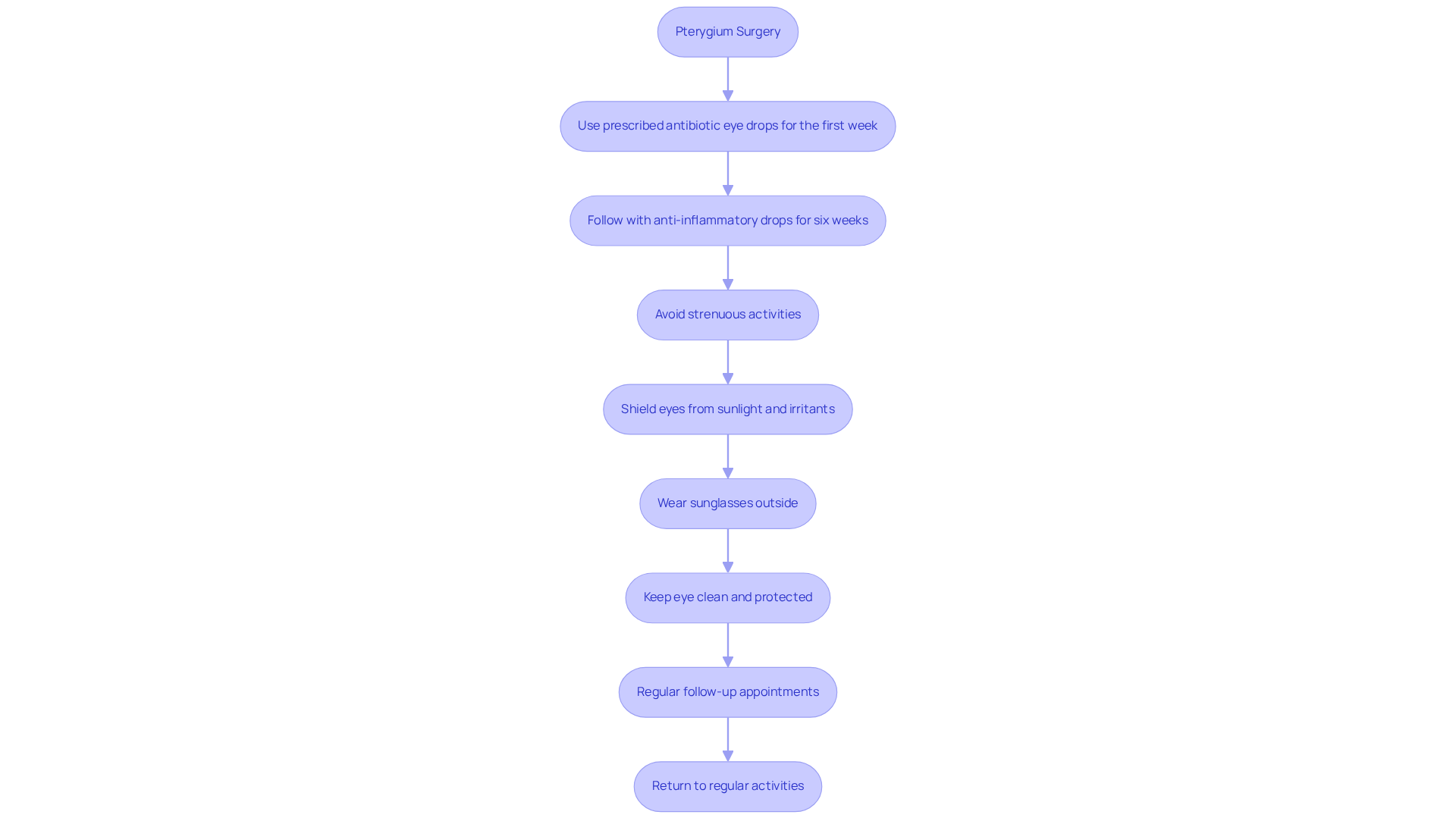
Risks of Pterygium Surgery: What You Should Know
We understand that considering can be daunting. While is generally considered safe, it’s essential to be aware of certain risks. Possible complications of pterygium surgery include:
- Infection
- Bleeding
- The chance of the growth returning
Research shows that can vary significantly depending on the technique used in pterygium surgery. For example, the in pterygium surgery has been found to have lower recurrence rates compared to the traditional bare sclera technique, which has historically shown rates as high as 88% in some instances. A recent study reported an overall recurrence rate of 7.65%, with primary cases at 6.13% and recurrent cases at 15.15%.
It’s common to feel anxious about the risks of pterygium surgery, but engaging in detailed conversations with your surgeon can help clarify the . Selecting a skilled practitioner and following instructions are vital steps in minimizing complications related to pterygium surgery. Specialists emphasize that during pterygium surgery, can significantly lower recurrence rates; however, these treatments may also carry their own risks.
Many patients share their experiences with pterygium surgery, highlighting the importance of being informed about potential complications. While common post-operative issues such as irritation and photophobia can occur following pterygium surgery, . By being knowledgeable and proactive, you can navigate the complexities of pterygium surgery and improve your chances of a positive outcome. We are here to help you through this process, ensuring you feel supported every step of the way.
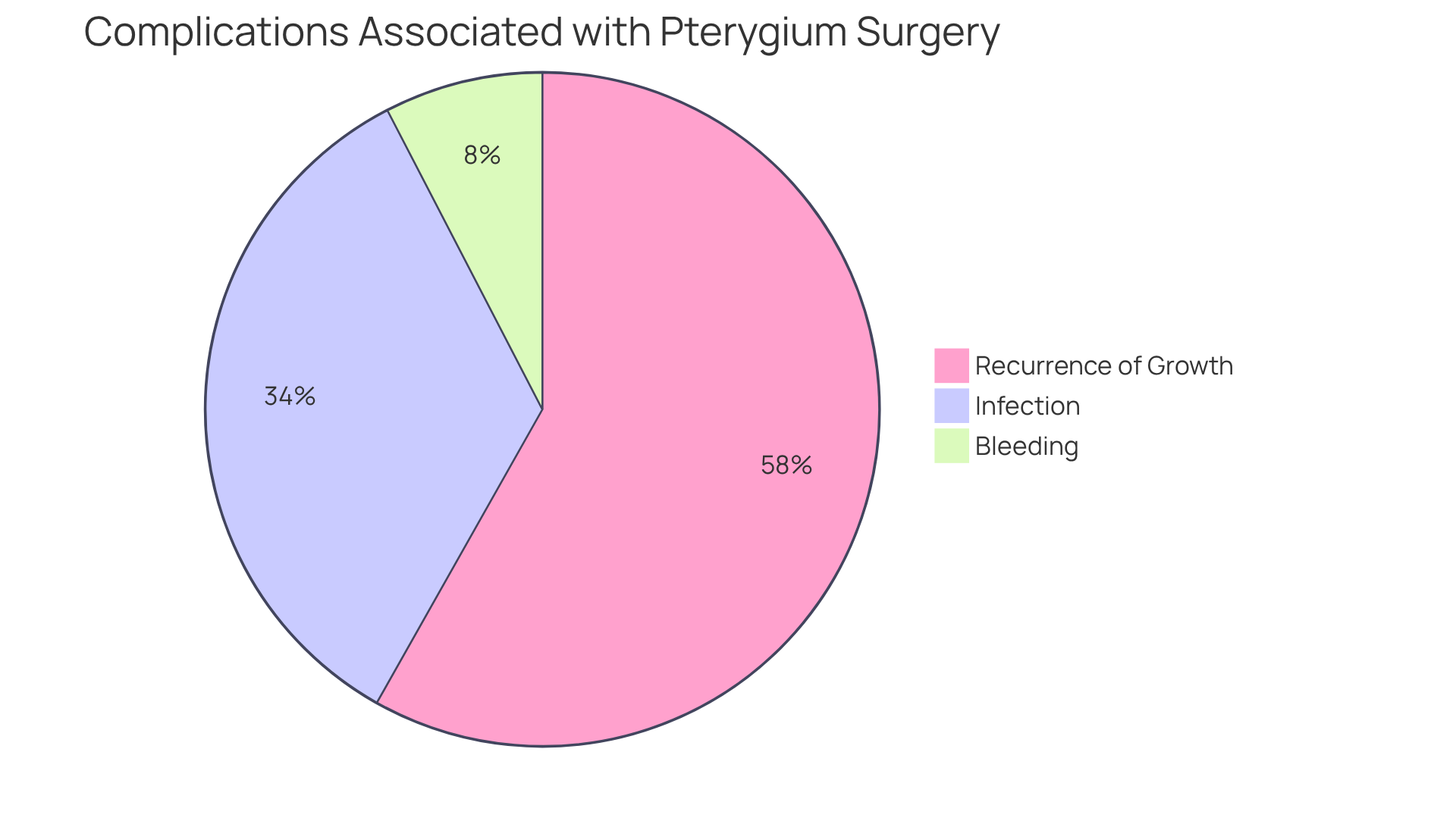
Non-Surgical Alternatives to Pterygium Removal
For individuals who may feel hesitant about surgery or those experiencing , we want you to know that can be quite effective. These options include:
- Lubricating eye drops to relieve dryness and irritation
- to manage inflammation
- to shield your eyes from harmful UV exposure and environmental irritants
We understand that wearing hats or caps with brims, along with using ultraviolet-blocking lenses, can provide additional protection.
Regular monitoring by an is crucial to and determine if pterygium surgery is necessary. It’s common to feel uncertain about the next steps, but studies indicate that approximately 80% of patients utilizing these report . This underscores the effectiveness of conservative management in alleviating symptoms and improving quality of life.
Experts emphasize that with these alternatives can prevent progression and the need for more invasive treatments. We are here to , ensuring you feel supported every step of the way.

Pterygium vs. Pinguecula: Key Differences Explained
Pterygium and pinguecula are both growths on the conjunctiva, yet they exhibit distinct characteristics and implications for eye health. We understand that noticing changes in your eyes can be concerning. A pinguecula appears as a small, yellowish and white, raised bump that typically does not encroach upon the cornea and is often asymptomatic. In contrast, a pterygium is a fleshy, triangular growth that can extend over the cornea, potentially leading to vision issues such as blurred sight and astigmatism. Both conditions are associated with . It’s common to feel discomfort or , which may require .
Symptoms linked to these eye conditions include:
- Redness
- Irritation
- A gritty feeling in the eye
unless it becomes troublesome. :
- Pinguecula often requires no treatment unless symptomatic, in which case lubricating eye drops may be recommended.
- On the other hand, if a or causes considerable discomfort, pterygium surgery may be necessary, particularly before it approaches the pupil edge to prevent lasting vision loss.
Understanding these differences is crucial for . As noted by experts, ‘, appearing as a fleshy, triangular structure that could hang over the cornea.’ are essential for early detection and intervention, especially for those at higher risk due to environmental factors such as sun exposure and dust. We are here to help you through this process, ensuring you receive the care and support you need.
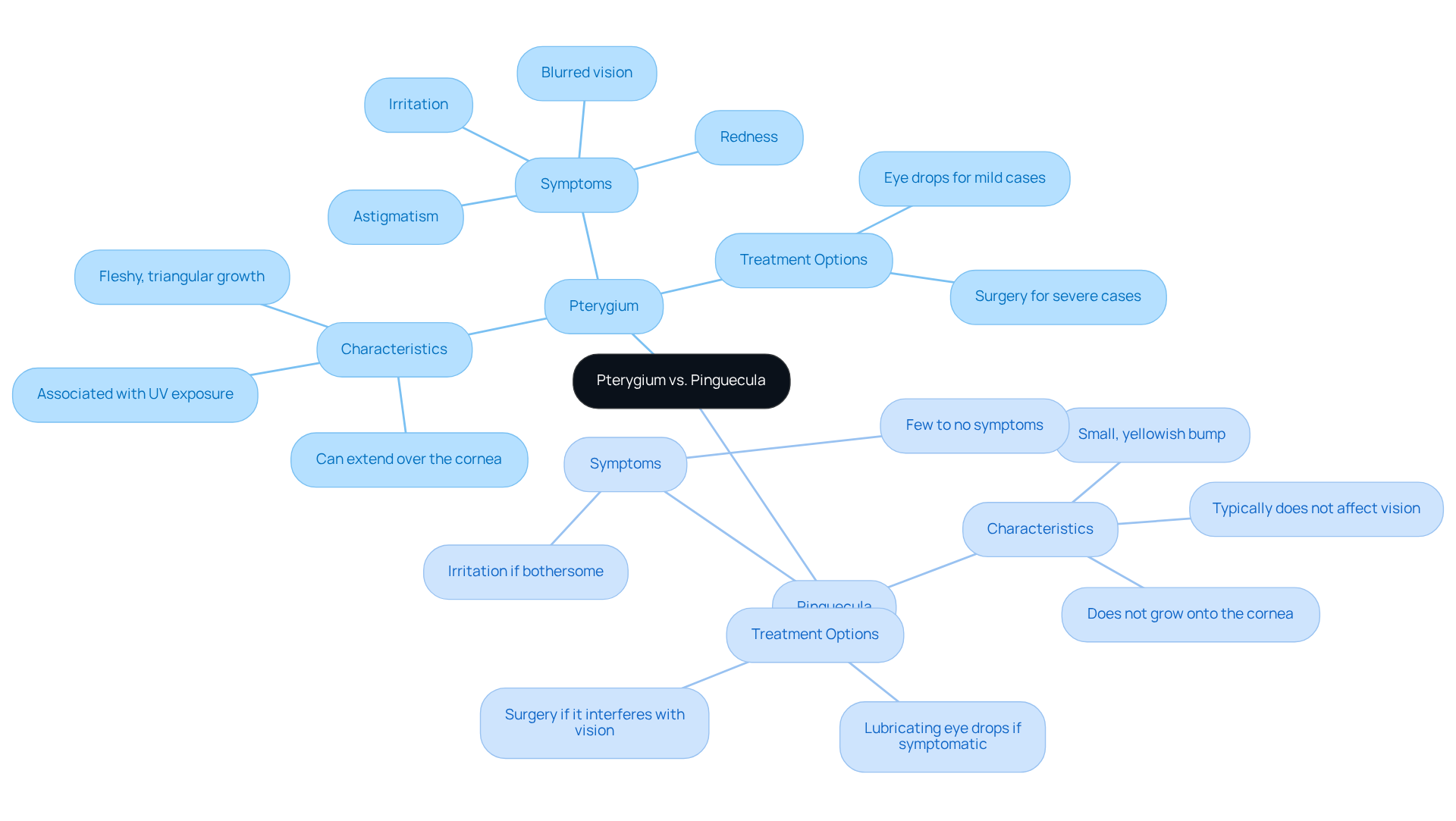
Cost of Pterygium Surgery: Financial Considerations
The expense of can vary significantly based on factors such as the surgical method used, the doctor’s expertise, and the location. We understand that navigating these costs can be overwhelming. On average, individuals can expect to spend around $3,825 for pterygium surgery, with $2,600 to $5,000. It’s common to feel uncertain about these expenses, but many do cover pterygium surgery if deemed medically necessary. We encourage patients to reach out to their insurance providers to .
Additionally, is crucial for effectively managing . At , we are here to support you with for qualified candidates, including:
- 0% interest financing for up to 24 months through CareCredit.
- Low-interest financing options for up to 60 months, with payments as low as $100 per month.
We also recommend considering (FSAs), which can help you save on by allowing the use of pre-tax dollars for eligible expenses. Grasping these financial factors is essential for making informed choices about your pterygium surgery, and we are here to assist you through this process.
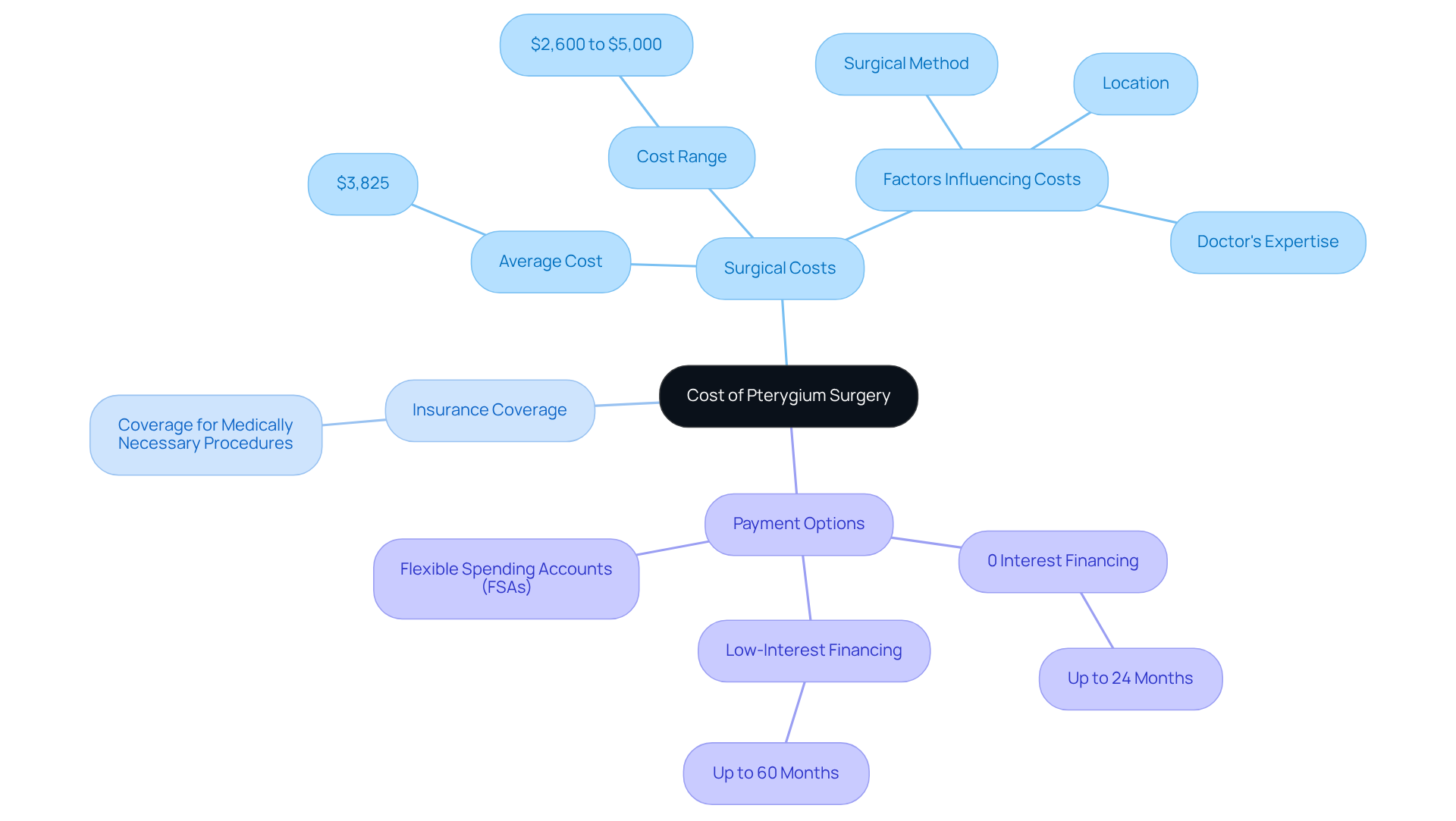
Preventing Pterygium: Effective Strategies to Consider
Avoiding this eye condition requires a proactive strategy to reduce exposure to its risk factors. We understand that taking steps for your can feel overwhelming, but essential strategies can make a .
- and wide-brimmed hats when outdoors, especially in sunny conditions, is crucial.
- These protective measures are vital, as ultraviolet light is recognized as the main factor in the development of this eye condition.
- As Dr. Brian Ang states, “The best way to protect from ultraviolet light damage is to wear 100% UV protection sunglasses,” emphasizing the importance of consistent use for .
In addition to UV protection, utilizing can help maintain eye lubrication and alleviate irritation caused by environmental factors.
- We want to remind you that play a critical role in the early detection and management of any changes in eye health, allowing for if necessary.
- It’s common to feel uncertain about your surroundings, but wearing or goggles in dusty or windy environments can minimize eye exposure and provide peace of mind.
It’s important to note that this eye condition does not resolve on its own; in mild cases, it may cease to grow, but in severe instances, it can block vision.
By implementing these , you can significantly lower your risk of developing this eye condition and . Patient experiences reinforce the effectiveness of these strategies, highlighting the importance of awareness and protective actions in maintaining optimal vision.
We are here to help you through this process and encourage you to take these steps for your eye health.
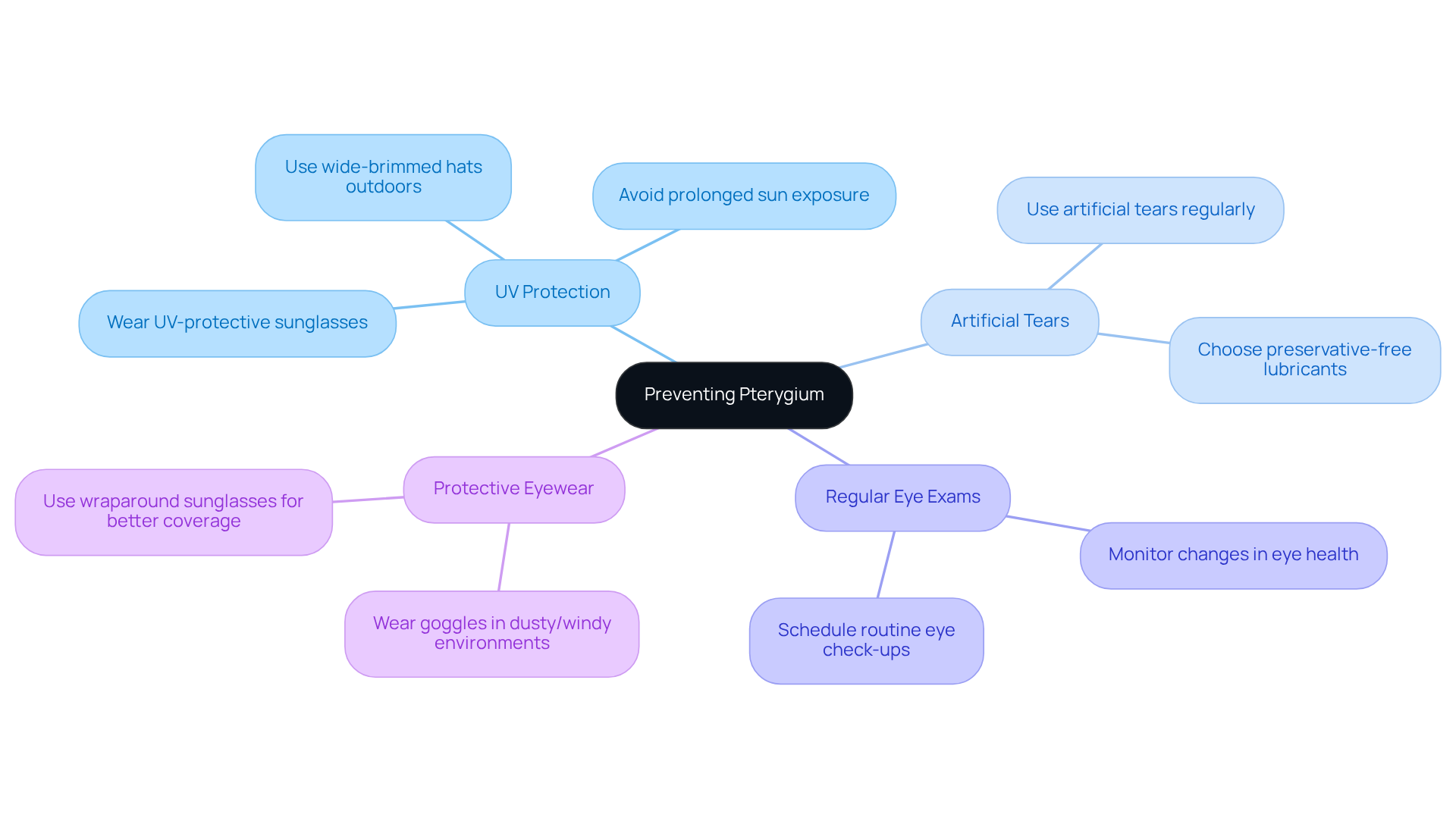
Frequently Asked Questions About Pterygium Surgery
Patients often have inquiries about , particularly regarding safety, recovery duration, and possible complications. We understand that these concerns are important to you. Here are some common inquiries:
- ? The process of pterygium surgery usually lasts approximately one hour for initial operations, while previously treated cases may require 1 to 2 hours.
- ? Most individuals can return to regular activities within a few days, but may take several weeks. Follow-up appointments are scheduled one day, one month, and three to four months post-surgery to monitor recovery and address any issues.
- Is the surgery painful? It’s common to feel mild discomfort, particularly in the first 24 to 48 hours, but pain is generally manageable with prescribed medications. Most patients require pain relief for only 1-3 days.
- ? While serious complications are rare, of pterygium surgery include infection, bleeding, and recurrence of the pterygium, which occurs in about 5% of cases despite optimal surgical techniques. The P.E.R.F.E.C.T technique, however, boasts a lower recurrence rate of approximately 0.1% for first-time surgeries. We encourage you to discuss any concerns with your surgeon to ensure a clear understanding of the procedure and its outcomes. Remember, we are here to help you through this process.
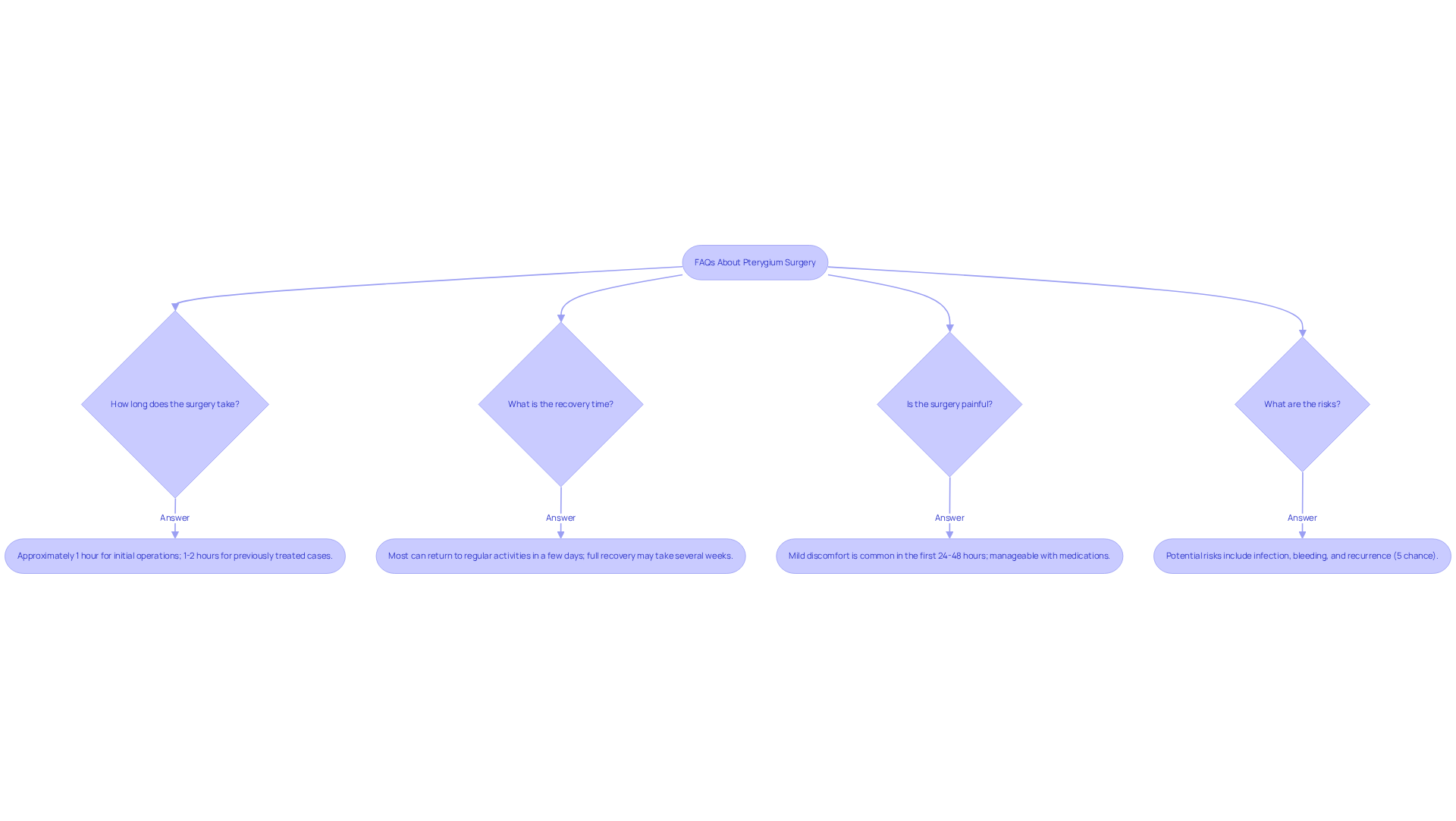
Conclusion
Understanding pterygium surgery is essential for anyone facing this eye condition. We understand that navigating this process can be overwhelming, and being informed about the surgical process, recovery expectations, and the various treatment options available is crucial. By recognizing the significance of early intervention and preventive measures, you can make empowered decisions regarding your eye health.
Key arguments discussed include:
- The effectiveness of conjunctival autografts in minimizing recurrence rates
- The necessity of protecting your eyes from UV exposure
- The potential risks associated with surgery
We want to emphasize the value of personalized care and ongoing support from experienced professionals, ensuring a smoother surgical journey for you.
Ultimately, taking proactive steps in your eye care can significantly impact your quality of life. Whether you are considering surgical options or exploring non-surgical treatments, staying informed and engaged with your eye health is crucial. We encourage you to consult with eye care specialists and prioritize protective measures to maintain optimal vision and prevent the onset of pterygium. Remember, we are here to help you through this process.
Frequently Asked Questions
What is pterygium, and what causes it?
Pterygium, often called “surfer’s eye,” is a benign growth of tissue on the conjunctiva that can encroach upon the cornea. It is primarily triggered by prolonged exposure to ultraviolet (UV) light, along with environmental factors like dust and wind.
What are the symptoms of pterygium?
Symptoms of pterygium can include redness, irritation, a sensation of a foreign object in the eye, and blurred vision. These symptoms may also indicate other underlying eye issues, so early recognition is important.
How is pterygium surgery performed?
During pterygium surgery, the surgeon carefully extracts the abnormal tissue from the eye, typically under local anesthesia. The procedure lasts about 30 to 45 minutes and may involve techniques such as conjunctival autografting to cover the area where the growth was removed.
What is conjunctival autografting, and why is it used?
Conjunctival autografting is a surgical technique where tissue is taken from the patient’s own conjunctiva to cover the area after pterygium removal. This method significantly reduces the risk of recurrence and enhances overall patient outcomes.
What can patients expect in terms of recovery after pterygium surgery?
Patients may experience mild discomfort post-surgery, but the procedure is generally well-tolerated. The use of techniques like conjunctival autografting aids in recovery and minimizes the likelihood of recurrence.
How experienced is the surgical team at Northwest Eye?
The surgical team at Northwest Eye has over 50 years of experience in eye care and is led by compassionate and experienced ophthalmic surgeons who utilize advanced techniques and state-of-the-art technology.
What ongoing research informs pterygium surgery practices at Northwest Eye?
Northwest Eye stays at the forefront of pterygium surgery management through ongoing research and case studies, including those that explore the use of fibrin glue fixation in surgical practices.
What should patients do if they experience symptoms of pterygium?
Patients experiencing symptoms such as redness, irritation, or blurred vision should seek medical intervention promptly, as early recognition can prevent serious health complications and improve treatment outcomes.






